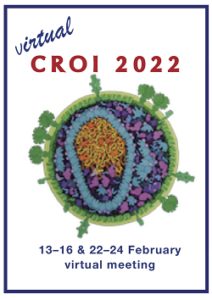CROI 2022: AAV8-VRC07 vaccine generates new bNAb production in HIV positive people for up to three years
1 March 2022. Related: Conference reports, Cure-related research, CROI 29 (Retrovirus) 2022.
 Kirk Taylor, HIV i-base
Kirk Taylor, HIV i-base
CROI 2022 included updated results from using an AAV8 vector virus to deliver HIV neutralising antibodies and that participants not only produced and sustained new antibodies but that these neutralised HIV in vitro. [1]
Broadly neutralising antibody (bNAb) therapies have been studied for a potential role in HIV cure-related research for over a decade. One challenge is whether treatment can lead to a recipients immune system producing the new antibody, limiting the need for repeated infusions. A second related challenge is the risk that the immune system can develop anti-bNAb antibodies (anti-drug antibodies; ADA) that reverse any potential benefit.
Initial results from the AAV8-VRC07 bNAb trial in eight HIV positive participants (six men and two women, with five African American and three Caucasian) were first presented two years ago at CROI 2020. This reported that de novo VRC07 was produced by participants in vivo. [1]
The researchers, led by Joseph J Casazza from the US NIAID and colleagues, now report VRC07 antibody levels and their ability to neutralise HIV-1 in the lab.
Participants on the AAV8-VRC07 trial had median baseline CD4 counts of 528 cells/mm3 (range: 351 to 950) at entry, no new participants have been included. [2]
Additional data were presented for participants that received low (n=3), intermediate (n=2) and high (n=3) vaccine doses. Five out of eight participants did not produce ADA and their VRC07 antibody levels have remained stable up to week 80 (intermediate and high dose) and week 130 (low dose).
However, bNAbs were maintained at lower levels for up to three years in participants with ADAs.
Antibodies collected from participants were capable of neutralising HIV in a similar manner to synthetic VRC07 (n=5). These experiments indicate that concentrations of VRC07 >1 ug/mL are required for 100% inhibition. Plasma concentrations of VRC07 were approximately ten-fold lower and maximal inhibition ranged from 60 to 90%.
This study therefore reported sustained long-term stability of AAV8-mediated VRC07 bNAb production in 5/8 participants and that these antibodies were active in vitro.
comment
Early bNAb studies (e.g. the Miami macaque) gave hope of a functional cure after sustainable production of two bNAbs (3BNC117 and 10-1074) led to undetectable viral loads over 2 years and a reduced viral reservoir. [3]
In response to a question from Dr Joseph Eron, the lead author confirmed that treatment interruptions are not currently planned in order to assess bNAb efficacy in vivo.
Instead, the team plan to use ultrasensitive testing to determine whether VRC07 can further reduce viral load.
Another study at CROI 2022 using romidepsin with 3BNC117 and ART reported a positive effect on reducing the reservoir and maintaining undetectable viral loads in some participants following treatment interruption a year later. [4]
A recent study in Nature employed an mRNA vaccine approach (technology used for Pfizer-BioNTech COVID-19 vaccine) to induce production of bNAbs against HIV-1 envelope proteins in macaques. Whilst the authors described a 79% reduction in the chance of macaques becoming SIV positive, there was no effect of vaccination on viral load for SIV positive macaques (n=7). [5]
It will be interesting to see whether this approach can be developed for HIV treatment and prevention.
References
- Casazza J. et al. Durable human HIV-specific bNAb production 3 years after AAV8 mediated gene transfer. CROI 2022. Virtual 12-16 Feb 2022. Poster 498.
https://www.croiconference.org/abstract/durable-human-hiv-specific-bnab-production-3-years-after-aav8-mediated-gene-transfer/ - Jefferys R. A step forward for AAV-mediated delivery of bNAbs. (HTB 17 April 2020).
https://i-base.info/htb/37604 - Jefferys R. HIV vaccine update: the “Miami macaque” as proof-of-concept breakthrough? (HTB 22 January 2018)
https://i-base.info/htb/33166 - Jefferys R. CROI 2022: Targeting reservoir with ART + bNAb 3BNC117 + romidepsin maintained undetectable viral load off-ART for 3.7 years in one case. (HTB 16 February 2022).
https://i-base.info/htb/42209 - Zhang P et al. A multiclade env–gag VLP mRNA vaccine elicits tier-2 HIV-1-neutralizing antibodies and reduces the risk of heterologous SHIV infection in macaques. Nature Medicine, vol 27 (2234-2245). DOI:10.1038/s41591-021-01574-5. (09 December 2021).
https://www.nature.com/articles/s41591-021-01574-5
This report was first published on 18 February 2022.

